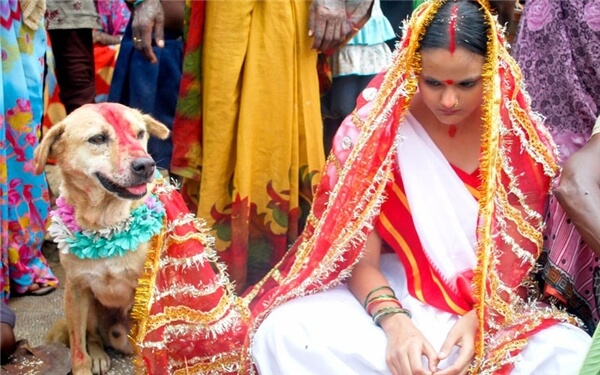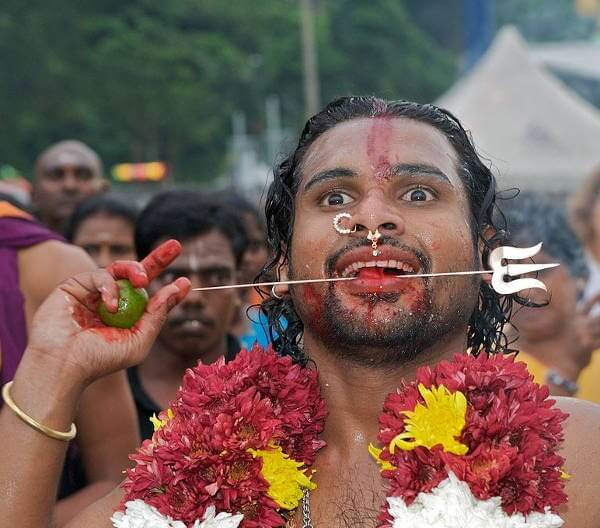Indian cultures and traditions are one of the oldest in the world. The majority of the population in India follow the Hindu religion. Hinduism is one of the most ancient in the world. Like many other religions around the world, Hindus have several godly rituals, beliefs and faiths. Certain rituals are extremely old and have been in existence for thousands of years. There are rituals in Hinduism which are weird and unbelievable. It is hard to believe such religious rituals exist in India even today. You will be surprised to know them.
The 10 crazy ancient Hindu rituals which are unbelievable:
10. Coconut Breaking on Head
We know that knocking on the head with the knuckles is painful. But, do you know in certain parts of South India, coconuts are broken on heads of devotees by the temple priests? It is a religious observance which bring peace and good luck in their struggling life as per the faith and belief of devotees. Sometimes, it injures the head. This dangerous ritual is performed by thousands of devotees who assemble in the temple premises on certain festivals. Even though the act is painful, many do not want to stop the ancient ritual which began in the 19th Century.
9. Animal Sacrifice
Slaughter of animals such as goats, buffaloes and cocks form a major part of a festival to honor a Hindu God. This is a 2000 years old ritual. Many courts in India believe that this act is barbaric and shouldn’t happen at a religious place. According to the faith and tradition, spillage of blood is a must so that the evil spirits vanish. Animal sacrifice is done for the welfare of the land and its people. There is mention of this practice even in Rig Veda, the oldest of Hindu scriptures. The deity is invariably an aspect of Goddess Durga or Kali. It is believed that the victims of the sacrifice go to heaven.
8. Baby Tossing
This is a 700 years old ritual and an annual affair. In Baba Umer Dargah, Solapur, India, babies are thrown at a height of 15m, onto a cloth or bed-sheets held by people. It is considered to bring good health and luck to the children. In the same state of Maharastra, similar practices are observed from a temple tower in a village known as Haranga. The terrified babies scream and sob. It is hard to watch the terrified babies. But, the participants argue that it is their religious duty. However, the babies’ traumas are not given importance. Despite the protest from India’s National Commission for Protection of Child’s Rights, the rituals still continue.
7. Nag Panchami – Festival of the Snake
This ritual dates back to the times of Mahabarata, the epic Indian story. It is a traditional worship of snakes with milk, sweets, flowers and lamps. Snakes always have great association with Hindu Gods like Shive, Vishnu, Devi and Subramanya. Snakes adorn the neck of Lord Shiva, recline Lord Vishnu and is a weapon of many Gods and Goddesses. To ward off the curse from “Nag” (Snake), devotees worship to bring good luck, good health and to free from snake bites. It is believed that Nag Panchami strengthens bonds between brothers and sisters.
6. Bani Festival
In the Indian state of Andhra Pradesh, there is a worship place known as Devaragatta Temple in Kurnool district where devotees throng with long sticks. They hit each other on heads to kill or get killed. Every Dussehra night, the ritual takes place to commemorate Lord Shiva who killed demon. It is reported that this gruesome ritual have been taking place for over 100 years now. The concept may be complicated but people are never afraid of getting killed. Police and medical staff are posted to monitor the event.
5. Tongue Piercing & Hooking
Tongue piercing is an ancient practice in India where people have spikes or iron needles or wooden needles driven through their tongues. This ritual mostly happens in Tamil Nadu and West Bengal. The painful ritual is observed in the hope that the searing pain will cleanse their soul and elevate them to a higher status. Insertion of iron hooks into the skin and hanging upside down are the other forms of body piercing to appease the Hindu God, Lord Murugan. The high decibel drumming and chanting during the festival make the devotees to enter into a trance.
4. Fire Walking
Walking barefoot across a mat of firewood or glowing charcoal is done in South India to honor the Hindu Goddess Draupati Amman. Participants suffer from burns on their feet and sometimes grievous injuries. The earliest reference of fire walking can be dated back to 1200 BC during the Iron Age India. It is a test of an individuals’ faith in religion. It is believed that if an individual is a true devotee of Goddess Draupadi, then he/she will walk through the fire unscathed. It is more of a ceremony or ritual of self-purification to attain spiritualism. Fire walking is a medium to prove one’s innocence who was accused of a crime.
3. Animal Wedding
Among certain sections of the Indian villages, there is a strong belief and faith that marrying animals would appease the Rain God and bring rain. Frog wedding, donkey wedding and dog or goat weddings are common. Animal wedding is conducted with big celebration with a priest in place. A grand feast also follows. Sometimes, in India the exorcised girls are married to animals to ward off the evil spirit. The news of such animal weddings finds a place regularly in the Indian newspapers.
2. Cannibal Aghori Monks of Varanasi
An Aghori is a peculiar clan of Sadhus or monks. Aghoris are the devotees of Hindu Lord Shiva or Bhairava, who seek moksha (freedom) from the cycle of reincarnation. They usually live on the banks of the river Ganga in the Indian city of Varanasi. Their food habits are bizarre. They eat rotten food, animal urine, putrefying human flesh and sometimes even excreta. Several strange rituals are performed before becoming an Aghori and the Aghoris perform peculiar rituals to free from the cycle of reincarnation.
1. Sati – Self Immolation
The ancient societies of India accepted the strange custom of immolation by recently widowed women on their husband’s funeral pyre. The practice is dated back to the 1st Century. In certain ethnic groups, the widows are glad to die who are honored. Those who decline are disgraced. There is a theory behind the “Sati” practice that it was to avoid the wives poisoning their rich husbands. In the 14th and 15th Century, Rajasthan and Madhya Pradesh of India saw a collective suicide of widows who preferred death rather than being captured alive by the victorious army.









